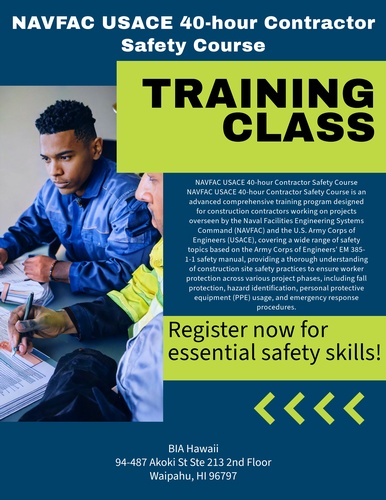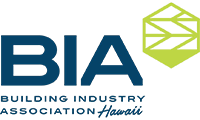Date and Time
Wednesday Mar 5, 2025
7:00 AM - 3:30 PM HST
Date: March 5,7,11,24,25
Time: 7:00AM - 3:30PM
Location
BIA Hawaii
94-487 Akoki St.
Waipahu, HI 96797
Meeting link; https://www.anymeeting.com/BIAEducation
Fees/Admission
$1250 or click here for form: $625 ETF
Registration Cancellation Policy:
Registration payments are 100% refundable up to 2 weeks prior to the class date. Any cancellation fees less than 2 weeks are 50% refundable.
Website
Contact Information
Eva Marie Whitworth (808) 679-7504
Send Email

Description
NAVFAC USACE 40-hour Contractor Safety Course NAVFAC USACE 40-hour Contractor Safety Course is an advanced comprehensive training program designed for construction contractors working on projects overseen by the Naval Facilities Engineering Systems Command (NAVFAC) and the U.S. Army Corps of Engineers (USACE), covering a wide range of safety topics based on the Army Corps of Engineers' EM 385- 1-1 safety manual, providing a thorough understanding of construction site safety practices to ensure worker protection across various project phases, including fall protection, hazard identification, personal protective equipment (PPE) usage, and emergency response procedures. Key points about the course: Duration: 40 hours of training Focus on EM 385-1-1: The course primarily aligns with the USACE's EM 385-1-1 safety manual, which outlines detailed construction safety standards. Target audience: Construction workers, supervisors, and safety personnel involved in projects managed by NAVFAC and USACE. Typical topics covered in the course: General safety awareness: Basic safety principles, incident reporting, and accident prevention Fall protection: Proper use of fall arrest systems, fall hazard identification, and anchor point selection Excavation safety: Safe excavation practices, shoring requirements, and trench safety procedures Confined space entry: Procedures for entering confined spaces, atmospheric monitoring, and rescue operations Hazardous materials handling: Identification and proper handling of hazardous materials, spill response procedures Electrical safety: Safe work practices around electrical equipment, lockout/tagout procedures Crane and hoist operations: Safe operation of cranes and hoists, signal communication procedures Fire safety: Fire prevention measures, fire extinguisher usage, emergency evacuation plans Personal protective equipment (PPE): Proper selection and usage of PPE based on job tasks Occupational health: Identifying and managing workplace health hazards, exposure monitoring

